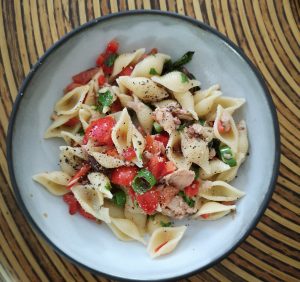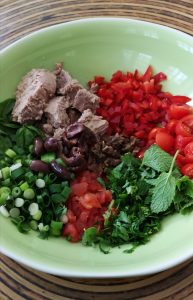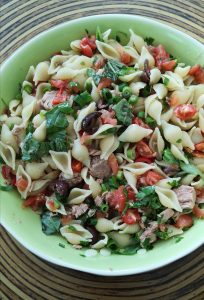
It’s summer. It’s hot. You’re hungry, you don’t feel like cooking. The kitchen is your least favourite place on earth.
Ta-daaa! Beach Pasta.
This recipe is adapted from the original in the classic Pasta Fresca by Viana La Place and Evan Kleinman, and is still one of my go-to favourites for scorching summer days. Don’t bother using fresh tuna for this, it’s meant to be made with good quality, chunk tuna in oil. The salty anchovies provide that perfect umami for when your tastebuds are feeling bleak. I add some chopped capers too, and extra fresh herbs like parsley, mint, dill and chives when I have them. I also like to chop up some cherry tomatoes, sweet red pepper and spring onion for an extra bit of texture.
So there ya go: two ticks, and food is on the table.


BEACH PASTA
Serves 4 – 6
Ingredients:
5 large very ripe red tomatoes
1 punnet cherry tomatoes, rinsed and chopped any old how
1 small sweet red pepper, seeded and chopped into very small dice
a handful of fresh basil leaves, torn (cutting makes the leaves turn black)
a handful of any fresh herbs you fancy: mint, parsley, dill, chives, chopped finely
4 large spring onions, washed and sliced finely including as much of the green part as possible
1/2 cup black Kalamata olives, pitted and roughly chopped up (not too small)
2 x 170g cans chunk tuna in sunflower oil, drained and loosely broken up with a fork
4 or 5 anchovy fillets, chopped finely ( if you really hate ’em, just leave out and use 1/4 cup chopped capers instead)
salt and freshly ground black pepper
1/2 – 1 cup of extra virgin olive oil
1/3 cup Marbrin fennel-infused extra virgin olive oil (optional) *order extra virgin olive oil, infused oils and imported Italian balsamic vinegar directly, read more here: Marbrin Boutique Olive Farm
500g pack imported medium-sized pasta shells (I favour Barilla pasta for this and any other pasta dish. Read more about Barilla at the end of the post.)
Method:
- Peel the large tomatoes by making a small cut in the peel of each one, place in a deep bowl and then pour over enough boiling water to cover the tomatoes completely. Let stand for 20 minutes or so, while you prepare the rest of the ingredients. When the skins have loosened, peel, quarter, cut away the core and seeds and chop flesh into small cubes.
- Place chopped tomatoes, diced sweet pepper, herbs, chopped spring onion, olives, tuna and anchovies (or capers) in a large serving bowl. Season well with black pepper. You might not need added salt, as the olives and anchovies (or capers) are already salty. Wait until the end to taste and add more salt if necessary.
- Put a large pot of very well-salted water on the stove and bring water to a rolling boil. Add pasta, stir briefly, and cook until just al dente. The pasta must still have some bite to it, otherwise your Beach Pasta is going to be a soggy mess.
- Once the pasta is cooked, quickly drain it in a colander and add pasta to the tomato-herb mix. Pour over the oil. Toss very well to combine, taste for salt and serve at room temperature. The Beach Pasta will keep well in the fridge for up to 3 days in an airtight container.
ABOUT BARILLA PASTA
Barilla – Italy’s No. 1 pasta brings the taste of Italy to your kitchen
Barilla, Italy’s No. 1 pasta, has been the cornerstone of Italian cuisine for over 140 years.
Made of the best quality 100% durum wheat semolina and inspired by authenticity and family tradition, Barilla pasta is the preferred choice of the world’s top chefs.
“In Italy every person of my generation grew up with Barilla pasta in the classic blue box. Its presence in every store is hard to miss but above all, it’s the good quality and value that has made Barilla Italy’s favourite choice of pasta,” says master of pasta, Chef Giorgio Nava.
Proprietor of 95 Keerom which has been a bastion of authentic Italian dining in Cape Town for the past 15 years, Chef Giorgio won the Barilla World Pasta Championship in 2013 and is an ambassador of Academia Barilla in Parma.
Barilla pasta comes in a myriad of shapes giving home cooks and master chefs alike ample variety to demonstrate their creative flair. When it comes to the cooking process, however, the pasta masters stand united: Pasta must always be cooked al dente. Directly translated al dente means ‘to the tooth’ or firm to the bite.
“Pasta should never be soft or over-cooked. A firmer pasta texture has a better mouth-feel and taste to enrich your favourite sauces, but there are also real health benefits to cooking your pasta al dente,” explains Chef Giorgio.
Pasta made from durum wheat semolina and is cooked al dente has a lower glycaemic index (GI) than other starches. The protein structure of durum wheat pasta lends elasticity and strength, and when cooked al dente, is digested more slowly than most other carbohydrates.
Lower GI foods help to regulate your blood sugars. Soft pasta has a higher GI as the longer cooking time accelerates the gelatinisation of the starch.
“The firmer the pasta, the longer the digestion time which means a lower spike in blood sugars,” adds Chef Giorgio.
In Italy the golden rule for cooking pasta is 1:10:100 which translates to 1-litre of water, 10g of salt and 100g of pasta. The cooking time will depend on the cut and shape of the pasta. Follow the cooking time on the Barilla box and make sure the pasta is slightly resistant to the bite by tasting your pasta while it’s cooking for the best results.
An essential part of the healthy Mediterranean diet, pasta is the culinary heart of Italy. Pasta shapes come in a wide variety of forms that have their origins in different Italian regions. Traditionally long cut pastas such as spaghetti, linguine and tagliatelle are ideal for soaking up light olive oil or tomato based sauces as well as a heartier Bolognese sauce. Short cut pasta on the other hand such as penne or shell shaped pasta, is perfect for capturing chunkier sauces like hand cut beef ragu or vegetables.
“Perfectly cooked pasta al dente is good for your health and good for the soul,” adds Chef Giorgio.
Qualities that set Barilla pasta apart
- Made of 100% semolina, the inner part of durum wheat kernels
- Golden amber colour
- Al dente quality
- Low GI energy food
- Water remains clear during cooking with no excess starch
- Protein structure lends elasticity and strength
- It does not break or stick during cooking and will always hold its shape
The story of Barilla
The Barilla Group is a famous Italian family owned, global food company whose commitment to quality, authenticity, innovation and improving people’s lives, has stood the test of time. It all began in 1877 when Pietro Barilla opened his family pasta and bakery shop in Parma. During his lifetime the business grew into a successful company culminating in the establishment of the first Barilla factory in 1910. Continuing the family legacy, his sons, grandsons and great grandsons took his vision further establishing Barilla factories across Italy, Europe and the world. Today this family owned business, headed by Guido, Luca and Paolo Barilla, is a truly international company with representation in over 100 countries and 29 manufacturing sites throughout the world. Uncompromising when it comes to quality and best practice in manufacturing, nutrition and protecting the environment, the Academia Barilla was founded in 2004 followed by the Barilla Centre for Food and Nutrition in 2009.
Despite its size, the Barilla company remains inspired by the mantra of founder Pietro Barilla: “Give people food you would give to your own children.”